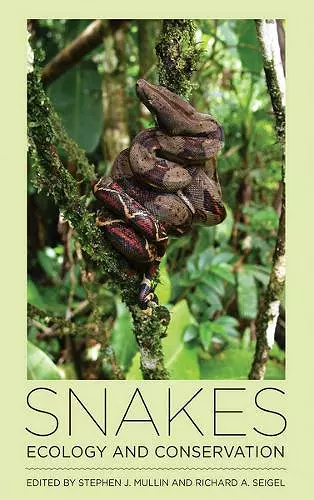Snakes
Ecology and Conservation
Richard A Seigel editor Stephen J Mullin editor
Format:Hardback
Publisher:Cornell University Press
Published:15th Jun '09
Currently unavailable, and unfortunately no date known when it will be back

Destruction of habitat due to urban sprawl, pollution, and deforestation has caused population declines or even extinction of many of the world's approximately 2,600 snake species. Furthermore, misconceptions about snakes have made them among the most persecuted of all animals, despite the fact that less than a quarter of all species are venomous and most species are beneficial because they control rodent pests. It has become increasingly urgent, therefore, to develop viable conservation strategies for snakes and to investigate their importance as monitors of ecosystem health and indicators of habitat sustainability.
In the first book on snakes written with a focus on conservation, editors Stephen J. Mullin and Richard A. Seigel bring together leading herpetologists to review and synthesize the ecology, conservation, and management of snakes worldwide. These experts report on advances in current research and summarize the primary literature, presenting the most important concepts and techniques in snake ecology and conservation. The common thread of conservation unites the twelve chapters, each of which addresses a major subdiscipline within snake ecology. Applied topics such as methods and modeling and strategies such as captive rearing and translocation are also covered. Each chapter provides an essential framework and indicates specific directions for future research, making this a critical reference for anyone interested in vertebrate conservation generally or for anyone implementing conservation and management policies concerning snake populations.
Contributors: Omar Attum, Indiana University Southeast; Steven J. Beaupre, University of Arkansas; Xavier Bonnet, Centre National de la Recherche Scientifique; Frank T. Burbrink, College of Staten Island-The City University of New York; Gordon M. Burghardt, University of Tennessee; Todd A. Castoe, University of Colorado; David Chiszar, University of Colorado; Michael E. Dorcas, Davidson College; Lara E. Douglas, University of Arkansas; Christopher L. Jenkins, Project Orianne, Ltd.; Glenn Johnson, State University of New York at Potsdam; Michael Hutchins, The Wildlife Society; Richard B. King, Northern Illinois University; Bruce A. Kingsbury, Indiana University-Purdue University Fort Wayne; Thomas Madsen, University of Wollongong; Stephen J. Mullin, Eastern Illinois University; James B. Murphy, National Zoological Park; Charles R. Peterson, Idaho State University; Kent A. Prior, Parks Canada; Richard A. Seigel, Towson University; Richard Shine, University of Sydney; Kevin T. Shoemaker, College of Environmental Science and Forestry, State University of New York; Patrick J. Weatherhead, University of Illinois; John D. Willson, University of Georgia
"Snakes: Ecology and Conservation is an important and excellent book. The choice of topics is timely and each chapter offers something novel." -- Harry W. Greene, Cornell University, author of Snakes: The Evolution of Mystery in Nature
"This timely compilation by Stephen J. Mullin and Richard A. Seigel, with contributions by the world's top experts in snake biology, will rapidly become the foundation for future herpetological research and management involving snakes. In addition to being an indispensable source for every professional herpetologist and anyone else interested in snake ecology and conservation, this book will serve as a cornerstone reference for land managers and conservation biologists anywhere snakes occur." -- J. Whitfield Gibbons, University of Georgia
"Yet another authoritative and cutting-edge volume on the biology of snakes, organized and written with the same attention to detail and scientific accuracy as its predecessors, Snakes: Ecology and Evolutionary Biology and Snakes: Ecology and Behavior. Add this alongside them on your library bookshelf; it is an essential tome for all researchers interested in serpents." -- Joseph T. Collins, Director, The Center for North American Herpetology, and Herpetologist, The University of Kansas
ISBN: 9780801445651
Dimensions: 229mm x 152mm x 32mm
Weight: 907g
384 pages